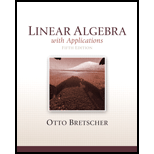
Consider a rotation
Want to see the full answer?
Check out a sample textbook solution
Chapter 7 Solutions
Linear Algebra with Applications (2-Download)
- ◄ Listen A vacant lot is being converted into a community garden. The garden and a walkway around its perimeter have an area of 560 square feet. Find the width of the walkway (x) if the garden measures 15 feet wide by 19 feet long. Write answer to 2 decimal places. (Write the number without units). X 15 feet Your Answer: 19 feet Xarrow_forwardListen A stuntman jumps from a roof 440 feet from the ground. How long will it take him to reach the ground? Use the formula, distance, d = 16t2, (where t is in seconds). Write answer to 1 decimal place. (Write the number, not the units). Your Answer:arrow_forwardSolve x² - 10x + 24 = 0 ○ A) 4,6 B) -12, -2 C) 12,2 D) -4, -6arrow_forward
- Factor the polynomial completely. x^2- 9 A) (x - 1)(x -9) B) (x - 3)(x + 3) c) (x -3)(x-3) D) (x + 3)(x + 3)arrow_forwardDirections: Use the equation A = Pet to answer each question and be sure to show all your work. 1. If $5,000 is deposited in an account that receives 6.1% interest compounded continuously, how much money is in the account after 6 years? 2. After how many years will an account have $12,000 if $6,000 is deposited, and the account receives 3.8% interest compounded continuously? 3. Abigail wants to save $15,000 to buy a car in 7 years. If she deposits $10,000 into an account that receives 5.7% interest compounded continuously, will she have enough money in 7 years? 4. Daniel deposits $8,000 into a continuously compounding interest account. After 18 years, there is $13,006.40 in the account. What was the interest rate? 5. An account has $26,000 after 15 years. The account received 2.3% interest compounded continuously. How much was deposited initially?arrow_forwardTRIANGLES INDEPENDENT PRACTICE ription Criangle write and cow Using each picture or description of triangle write and solve an equation in ordering the number of degrees in each angle TRIANGLE EQUATION & WORK ANGLE MEASURES A B -(7x-2)° (4x) (3x)° (5x − 10) C (5x – 2) (18x) E 3. G 4. H (16x)° LL 2A= 2B= ZE=arrow_forwardarrow_back_iosSEE MORE QUESTIONSarrow_forward_ios
 Elementary Linear Algebra (MindTap Course List)AlgebraISBN:9781305658004Author:Ron LarsonPublisher:Cengage LearningAlgebra & Trigonometry with Analytic GeometryAlgebraISBN:9781133382119Author:SwokowskiPublisher:Cengage
Elementary Linear Algebra (MindTap Course List)AlgebraISBN:9781305658004Author:Ron LarsonPublisher:Cengage LearningAlgebra & Trigonometry with Analytic GeometryAlgebraISBN:9781133382119Author:SwokowskiPublisher:Cengage Linear Algebra: A Modern IntroductionAlgebraISBN:9781285463247Author:David PoolePublisher:Cengage Learning
Linear Algebra: A Modern IntroductionAlgebraISBN:9781285463247Author:David PoolePublisher:Cengage Learning College AlgebraAlgebraISBN:9781305115545Author:James Stewart, Lothar Redlin, Saleem WatsonPublisher:Cengage Learning
College AlgebraAlgebraISBN:9781305115545Author:James Stewart, Lothar Redlin, Saleem WatsonPublisher:Cengage Learning




